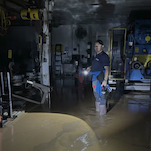When a cop isn’t a cop: The troubling rise of reserve officers
A 73-year-old reserve deputy in Tulsa, Oklahoma, has been charged with manslaughter after he mistook his gun for a Taser and shot a suspect dead during a botched sting operation.
In itself, that headline is both troubling and tragic. But when it became public that Robert Bates, the reserve officer, had gained that post after donating thousands of dollars in equipment to the police department, as well as to the sheriff’s reelection campaign in 2012, questions arise about the integrity of reserve programs, not only in Tulsa, but around the country.
Turns out reserve programs are being used as a backstop for departments with recruitment issues, and in some cases the less-trained reserves have made serious mistakes while moonlighting as an officer of the law.
Take the police department in Albuquerque, New Mexico. The department, which is in a class of its own for use of force issues, is in the midst of a recruitment crisis, leading to a chronically understaffed department. Out of 1,000 officers the department is authorized to employ, only 874 are active, with an estimated 404 patrolling the streets, according to a recent report by the Albuquerque Journal.
As a result, the department’s entire crime scene forensics work will soon be taken over by civilians, reported the paper, so that the 12 officers who are on that unit can go back on patrol. Even the department’s bomb squad has been relying on civilians to do the job at least one day every week.
A police association representative told the paper that about 160 active officers will become eligible for retirement this year, only exacerbating the crisis and the department’s use of reserve officers, who receive less training than full duty officers.
In 2009, the department was forced to suspend its reserve program after it was discovered that a reserve officer was making illegal arrests and getting paid overtime to do so. Several women whom he arrested for prostitution served six months or more in prison for the illegal arrests, cases which the Albuquerque public defender’s office called “clearly fraud perpetrated against the court.”
Efforts to ask the Albuquerque Police Department how the reserve program had been changed or reformed since that suspension were not immediately answered.
“We are [in] crisis mode now, but it will only escalate,” Stephanie Lopez, president of the Albuquerque Police Officers’ Association told the Albuquerque Journal. The force has fewer officers on payroll than it has had since 2001.
-

-

-

-

-

-

-

-

-

-

-

-

-

-

-

-

-

-

-

-

-

-

-

-

-

-

-

-

-

-

-

-

-

-

-

-

-

-

-

-

-

-

-

-

-

-

-

-

-

-

-

-

-

-

-

-

-

-

-

-

-

-

-

-

-

-

-

-

-

-

-

-

-

-

-

-

-

-

-

-

-

-

-

-

-

-

-

-

-

-

-

-

-

-

-

-

-

-

-

-

-

-

-

-

-

-

-

-












































































































